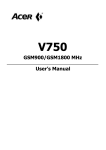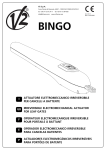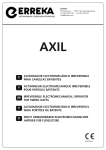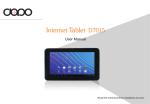Download BenQ S80 User`s manual
Transcript
BenQ S80 Mobile Phone User’s Manual Copyright © 2005. BenQ Corporation. All rights reserved. No part of this publication may be reproduced, transmitted, transcribed, stored in a retrieval system or translated into any language or computer language, in any form or by any means, electronic, mechanical, magnetic, optical, chemical, manual or otherwise, without the prior written permission of BenQ Corporation. Disclaimer BenQ Corporation makes no representations or warranties, either expressed or implied, with respect to the contents hereof and specifically disclaims any warranties, merchantability or fitness for any particular purpose. Further, BenQ Corporation reserves the right to revise this publication and to make changes from time to time in the contents hereof without obligation of BenQ Corporation to notify any person of such revision or changes. Safety Information For your safety, please read the guidelines below carefully before you use your phone: Exposure to Radio Frequency Signals Max. SAR measurement EU: GSM900: 0.345 W/Kg; DCS1800: 0.256 W/Kg; WCDMA 2100: 0.648 W/Kg Your wireless handheld portable telephone is a low power transmitter and receiver. When it is ON, it receives and also sends out radio frequency (RF) signals. European and international agencies have set standards and recommendations for the protection of public exposure to RF electromagnetic energy. • International Commission on Non-Ionizing Radiation Protection (ICNIRP) 1996 • Verband Deutscher Elektringenieure (VDE) DIN- 0848 • Directives of the European Community, Directorate General V in Matters of Radio Frequency Electromagnetic Energy • National Radiological Protection Board of the United Kingdom, GS 11, 1988 • American National Standards Institute (ANSI) IEEE. C95.1- 1992 • National Council on Radiation Protection and Measurements (NCRP). Report 86 • Department of Health and Welfare Canada. Safety Code 6 These standards are based on extensive scientific review. For example, over 120 scientists, engineers and physicians from universities, government health agencies and industry reviewed the available body of research to develop the updated ANSI Standard. The design of your phone complies with these standards when used normally. Safety Information i Specific Operating Restrictions No metallic component allowed in body-worn accessories. Antenna Care Use only the supplied or approved replacement antenna. Unauthorized antennas, modifications or attachments may damage the phone and violate GCF regulations. Phone Operation • Normal Position: Hold the phone as you would with any other telephone. • To avoid potential RF interference, please do not wear the phone around your neck or in front your chest for long hours. Batteries • For safety concerns, when the temperature of the phone goes over 45°C (113F) or below 0°C (32F), charging will halt. • Do not expose batteries to temperatures below -10°C (14F) or above 45 °C (113F). Always take your phone with you when you leave your vehicle. • Use only genuine BenQ battery to ensure the phone’s normal operation. All batteries can cause property damage, injury or burns if a conductive material such as jewelry, keys or beaded chains touches exposed terminals. The material may complete electrical circuit and become quite hot. To protect against such unwanted current drain, exercise care in handling any charged battery, particularly when placing it inside your pocket, purse or other container with metal objects. When battery is detached from the phone, your batteries are packed with a protective battery cover; please use this cover for storing your batteries when not in use. ii Safety Information Driving Check the laws and regulations on the use of wireless telephones in the areas where you drive. Always obey them. Also, if using your phone while driving, please: • Give full attention to driving--driving safety is your first responsibility. • Use hands-free operation, if available. • Pull off the road and park before making or answering a call if driving conditions so require. Electronic Devices Most modern electronic equipment is shielded from RF signals. However, certain electronic equipment may not be shielded against the RF signals from your wireless phone. Pacemakers The Health Industry Manufacturers Association recommends that a minimum separation of six (6") inches be maintained between a handheld wireless phone and a pacemaker to avoid potential interference with the pacemaker. These recommendations are consistent with the independent research by and recommendations of Wireless Technology Research. Persons with pacemakers: • Should ALWAYS keep the phone more than six inches from their pacemaker when the phone is turned ON. • Should not carry the phone in a breast pocket. • Should use the ear opposite the pacemaker to minimize the potential for interference. If you have any reason to suspect that the interference is taking place, turn your phone OFF immediately. Hearing Aids Some digital wireless phones may interfere with some hearing aids. In the event of such interference you may want to consult your hearing aid manufacturer to discuss alternatives. Safety Information iii Other Medical Devices If you use any other personal medical device, consult the manufacturer of your device to determine if they are adequately shielded from external RF energy. Your physician may be able to assist you in obtaining this information. Turn your phone OFF in health care facilities when any regulations posted in these areas instruct you to do so. Hospitals or health care facilities may be using equipment that could be sensitive to external RF energy. Vehicles RF signals may affect improperly installed or inadequately shielded electronic systems in motor vehicles. Check with the manufacturer or its representative regarding your vehicle. You should also consult the manufacturer of any equipment that has been added to your vehicle. Posted Facilities Turn your phone OFF in any facility where posted notice so requires. Aircraft FCC regulations prohibit using your phone while in the air. Switch OFF your phone before boarding an aircraft. Blasting Areas To avoid interfering with blasting operations, turn your phone OFF when in a “blasting area” or in area posted “TURN OFF TWO-WAY RADIO.” Obey all signs and instructions. Potentially Explosive Atmospheres Turn your phone OFF and do not remove the battery when in any area with a potentially explosive atmosphere and obey all signs and instructions. Sparks, from your battery, in such areas could cause an explosion or fire resulting in bodily injury or even death. iv Safety Information Areas with a potentially explosive atmosphere are often, but not always clearly marked. They include fueling areas such as gasoline stations; below deck on boats; fuel or chemical transfer or storage facilities; vehicles using liquefied petroleum gas (such as propane or butane); areas where the air contains chemicals or particles, such as grain, dust, or metal powders; and any other area where you would normally be advised to turn off your vehicle engine. For Vehicles Equipped with an Air Bag An air bag inflates with great force. DO NOT place objects, including both installed or portable wireless equipment, in the area over the air bag or in the air bag deployment area. If in-vehicle wireless equipment is improperly installed and the air bag inflates, serious injury could result. European Union Directives Conformance Statement This device complies with the OJ-Directive as below: Electromagnetic Compatibility Directive (89/336/EEC), Low Voltage Directive (73/23/EEC) And R&TTE Directive (99/05/EEC). And also complies with the standard: 3GPP TS 51.010-1 EN 301 511 EN 50360/ EN 50361 ETSI EN 301 489-1/-7 EN 60950 ETSI EN 301 908-2 & ETSI EN 301 489-24 (WCDMA) ETSI EN 300 328 & ETSI EN 301 489-17 (Bluetooth) Safety Information v vi Safety Information Table of Contents Safety Information ...........................................................i 1. Preparing Your Phone For Use................................... 1 Inserting a SIM Card ............................................................ 1 Installing the Battery ............................................................ 3 Charging the Phone.............................................................. 4 Turning the Phone On ......................................................... 5 The miniSD Card ................................................................. 6 2. Getting to Know Your Phone ..................................... 7 Your Phone at a Glance........................................................ 7 Sub Display ......................................................................... 10 Idle Screen .......................................................................... 10 Using the Keys in Idle Mode.............................................. 13 Menu Navigation................................................................ 15 3. Using Your Phone ..................................................... 16 Call Functions..................................................................... 16 Making a Phone Call ..............................................................16 Ending a Phone Call...............................................................16 Answering a Phone Call .........................................................16 Rejecting an Incoming Call....................................................16 Adjusting the Volume ............................................................16 Making an International Call ................................................17 Making an Emergency Call....................................................17 Dialing an Extension Number ...............................................17 Listening to Voicemails..........................................................17 Table of Contents vii Operations During a Call.......................................................18 Making a Video Call...............................................................22 Answering a Video Call..........................................................23 Video Call Settings .................................................................23 Options During a Video Call .................................................25 Phone Book......................................................................... 26 Adding Contacts to the Phone Book.....................................26 Finding Contacts in the Phone Book ....................................29 Last Missed, Dialed, and Received Calls............................ 29 Using the Silent Profile....................................................... 30 Camera ................................................................................ 31 Taking Pictures.......................................................................31 Camera Settings......................................................................32 More Camera Settings............................................................32 Managing Your Pictures ........................................................33 Camcorder .......................................................................... 33 Shooting a Video Clip ............................................................33 Camcorder Settings ................................................................34 More Camcorder Settings......................................................35 Managing Your Videos ..........................................................35 MP3 Player.......................................................................... 36 Building a play list ..................................................................36 Playing the music ...................................................................36 Uploading music to your phone............................................37 Messages.............................................................................. 38 SMS .........................................................................................38 MMS........................................................................................40 viii Table of Contents E-mail......................................................................................43 Voicemail ................................................................................44 Broadcast.................................................................................45 Input Modes ....................................................................... 46 Letter Input Mode (Abc) .......................................................46 Predictive Input Mode (iTap) ...............................................47 Numeric Input Mode (123)...................................................47 Symbol Input Mode ...............................................................48 Using the Bluetooth............................................................ 48 Establishing Connection with Your Bluetooth Headset ......48 Organizing your Devices........................................................49 PC Synchronization and Data Transfer ............................ 49 4. Menus ......................................................................... 50 Phone Book......................................................................... 50 List...........................................................................................50 Find .........................................................................................50 Add..........................................................................................50 Copy ........................................................................................50 Delete ......................................................................................51 Caller Group ...........................................................................51 Own Number..........................................................................51 Memory...................................................................................51 Messages.............................................................................. 51 Calls ..................................................................................... 52 Missed .....................................................................................52 Received ..................................................................................52 Dialed ......................................................................................52 Table of Contents ix Cleanup All .............................................................................52 Display ....................................................................................52 Duration and Cost..................................................................53 Games.................................................................................. 53 Settings....................................................................................53 Entertainment..................................................................... 54 Camera....................................................................................54 Camcorder ..............................................................................54 MP3 Player..............................................................................54 Media Center ...................................................................... 55 Images .....................................................................................55 Videos .....................................................................................56 Music.......................................................................................56 Others......................................................................................57 Tools.................................................................................... 58 Alarm ......................................................................................58 Clock Options.........................................................................58 Calendar..................................................................................59 Calculator................................................................................59 Currency Converter ...............................................................60 Stopwatch ...............................................................................60 Countdown Timer .................................................................60 Connections............................................................................61 Services................................................................................ 62 WAP Browser .........................................................................62 WAP Messages........................................................................62 WAP Settings ..........................................................................62 x Table of Contents STK..........................................................................................63 Settings ................................................................................ 64 Date & Time ...........................................................................64 Profiles ....................................................................................64 Display ....................................................................................66 Call Settings ............................................................................67 Network ..................................................................................70 Security ...................................................................................72 Power Saving ..........................................................................72 Language .................................................................................73 Power On/Off Sound .............................................................73 Memory...................................................................................73 Restore ....................................................................................73 5. Care and Maintenance .............................................. 74 6. Troubleshooting........................................................ 75 Table of Contents xi xii Table of Contents Preparing Your Phone For Use Inserting a SIM Card Please note: • In this user manual, "SIM card" implies either a SIM or an USIM card, unless it is specifically specified as "USIM card". • To use your mobile phone in the UMTS network, you will need to have a USIM card. See page 71, "3G/GSM Networks" to find out more about selecting the correct network mode for use. 1. Turn the phone over, and release the battery latch. Lift the battery off the phone. Battery latch Do not remove the battery when the phone is on. Doing so could cause you to lose personal settings or data stored either on your SIM card or in the phone's memory. Preparing Your Phone For Use 1 2. Slide the SIM card into the SIM card slot, with the SIM card's metal contacts facing downwards and the cut corner at the bottom left. SIM card A SIM card can be easily damaged if its metal contacts become scratched. Therefore, take special care when holding or inserting it. To remove the SIM card, you must first press down the stay, then push the SIM card out of the slot. Stay SIM card 2 Preparing Your Phone For Use Installing the Battery With the battery's metal contacts facing downwards, align the protruding tabs on the end with the holes in the battery bay. Then push the battery toward the end of the bay to insert the battery's tabs into the holes. Press down to click the battery into place. Do not remove the battery when the phone is on. Doing so could cause you to lose personal settings or data stored either on your SIM card or in the phone's memory. Preparing Your Phone For Use 3 Charging the Phone 1. Insert the charger connector deep into the charger socket at the bottom of your phone. Ensure that the connector is plugged in the right direction with the side showing arrow icon or "up" facing upwards. 2. Plug the charger into a power outlet. Do not remove the battery while the phone is charging. 3. Once the phone is fully charged, remove the charger from both the power outlet and the phone. Please note: • It takes approximately 4 hours to fully charge a battery. • When the battery is weak, the phone will play an alert sound. • When the battery is discharged, the charging may not start immediately when you plug in the connector. Wait 10 to 15 minutes for the phone to begin charging. 4 Preparing Your Phone For Use Turning the Phone On 1. Press and hold to turn the phone on. The phone will display the welcome animation. 2. Enter your PIN code and press to confirm. The PIN (Personal Identification Number) is the password provided by your network operator. You need this password in order to use the SIM card. If you enter the PIN incorrectly three times in a row, the SIM card will be locked. You must now enter the PUK (Personal Unblocking Key) for that SIM card in order to unlock it. Please contact your network operator to obtain a PUK. To activate/disable PIN password authentication, go to Settings > Security > PIN Code > PIN 1 Code > Settings. See page 72. 3. When the PIN code entered has been accepted, the phone will automatically search for the designated network. This search process may take a few seconds. 4. The idle screen will be displayed, as well as network signal strength and the name of the network operator. You can now use the phone. If the phone is not able to detect the designated network, or links to a network that you are not authorized to use, the signal strength meter will show no bars. You will only be able to make emergency calls. Preparing Your Phone For Use 5 The miniSD Card Your phone features a miniSD slot designed specifically for use with the miniSD card, a removable flash memory card intended to add greater storage capacity to your phone. The miniSD card enables you to store multimedia data such as images, photos, MP3 audio files, ring tones, and videos. Installing the miniSD Card 1. Lift the cover. 2. Insert the miniSD Card into the slot. Ensure that the card's metal contacts face downwards. 3. Close the cover. Your phone does not support a miniSD card which is on FAT32 or NTFS format. Removing the miniSD Card 1. Lift the cover. 2. Press the miniSD card to release it. 6 Preparing Your Phone For Use Getting to Know Your Phone Your Phone at a Glance Front and side views Sub display Antenna Front Camera Camera flash Charger socket Rubber cover IrDA port To view what is behind the rubber cover, lift the cover and twist it to the left. miniSD slot Hands-free headset / Data cable jack Getting to Know Your Phone 7 Side and back views Speaker Battery latch Camera hot key Volume key Battery 8 Getting to Know Your Phone Front open view Earpiece Main Display Near Camera Navigation key OK key Left soft key Video call hot key Dial/Answer key Right soft key Clear key Power on/off key WAP key Alphanumeric keys Microphone Getting to Know Your Phone 9 Sub Display When the flip is closed, the sub display will show icons for network strength, battery power, the current time and the current profile in use. The sub display will also alert you to incoming calls, new messages and missed calls. Idle Screen Status bar Name of network operator Press to enter the indicated function. Press to enter the Press to enter the main menu. indicated function. • To set the wallpaper of the display, go to Settings > Display > Wallpaper. Alternatively, you can go to Media Center > Images. See page 55 and page 66. • To set the current time and date, as well as the format to be shown, go to Settings > Date & Time. See page 64. 10 Getting to Know Your Phone Icons in the Status Bar Icon Function Description Signal strength Signal strength of the network. The more bars indicated, the stronger the signal. Battery status Shows the current level of battery power. The more bars indicated, the more power remains. GPRS in use Appears when GPRS has been activated. 3G in use Appears when 3G has been activated. GPRS Connection Appears when the phone is connecting to a GPRS network. 3G Connection Appears when the phone is connecting to a 3G network. Bluetooth Appears when Bluetooth is turned on. SMS Message Appears when you have new or unread SMS messages. Appears in red when your SMS messages are full. MMS Message Appears when you have new or unread MMS messages. Appears in red when your MMS messages are full. WAP message Appears when you have new or unread WAP messages. E-mail Appears when you have new or unread email messages. Appears in red when your e-mails are full. Getting to Know Your Phone 11 Icon Function Description Voicemail Appears when you have new voicemail messages (this icon will only appear if the function is supported by your network operator). Alarm Normal Shows that the Normal profile is activated. Flight Mode Appears when the Flight Mode profile is activated. Headset Appears when a headset is connected to the phone. Meeting Shows that the Meeting profile is activated. Silent Outdoors Divert Roaming 12 Appears when the alarm is turned on. Shows that the Silent profile is activated. Shows that activated. the Outdoors profile is Appears when the call divert is activated. Roaming is activated (not your regular network). Getting to Know Your Phone Using the Keys in Idle Mode In this user manual, "long-press" means to press and hold down a key for about two seconds. "Press" means to press a key and release immediately. Key Commands and functions Power on/off key • Long-press to turn the phone on or off. • Press this key to end a call, reject an incoming call, or to cancel a dialing. Send/Answer key • Press to send or answer a call. • Press to access the call record list. Left soft key • Press to perform the function indicated on the display. Right soft key • Press to perform the function indicated on the display. • Long-press to turn the silent profile on or off. OK key • Press to open up the main menu. Getting to Know Your Phone 13 Key Commands and functions Navigation key/Scroll key • Press to bring up the MP3 player. • Press to create a new SMS message. • Press to access Profiles. • Press to access Images. Video call hot key • Press to answer a video call. WAP hot key • Press to access WAP and more services that your network operator provides. Asterisk key • Press this key to enter an asterisk " * ". • To make an international call, long-press this key until the display shows "+", then enter the recipient's country code, area code and phone number. Voicemail key • Long-press to dial your voicemail number. # key • Press to enter "#". • For extensions: After entering a phone number, longpress to enter a "P" and then enter the extension number. Alphanumeric keys ~ 14 • Press to enter digits. Getting to Know Your Phone Key Commands and functions Volume key • Long press the upper or lower key to adjust the volume. Camera hot key • Long press to activate the camera mode. Menu Navigation 1. In idle mode, press to bring up the main menu. 2. Use the scroll key to move up, down, right or left through the menu, for example, scroll to Settings, and press to enter its menu. 3. Use the scroll key to scroll to a submenu, for example Profiles, and press to enter the submenu item. You can also access a menu item by pressing the corresponding menu number. In the above example, press to access Profiles. Getting to Know Your Phone 15 Using Your Phone Call Functions Making a Phone Call In idle mode, enter the phone number. Press to dial your call. Ending a Phone Call To end a call, press or close the flip. The display will show the total call time, and then return to idle mode. Answering a Phone Call To answer a call, press . Or, open the flip. Also you can answer a call by pressing the side key . If you wish to change the way of answering a call, go to Settings > Call Settings > Answer Mode. Rejecting an Incoming Call To reject an incoming call, press or close the flip. Also you can reject a call by long-pressing the upper volume key. To turn off the ring of the incoming call, long-press the lower volume key. Adjusting the Volume During a call, if you want to adjust the speech volume, you can press the volume key on the left side of the phone. Please note: 16 Using Your Phone • When there is an incoming call, you can mute the ring tone by longpressing the lower portion of the volume key. • Adjusting speech volume only works during a call. Making an International Call 1. Enter the outgoing international call code, or long-press "+" appears on the display. until 2. Enter the recipient's country code, area code and phone number. Dial the call by pressing . Making an Emergency Call To call emergency services, enter 112 (the international emergency number) and then press to dial the call. You can make an emergency call even if your phone is locked or cannot access your network, or there is no SIM card inserted, so long as you are within range of a network of the type supported by your phone. Dialing an Extension Number After you enter a telephone number, long-press until "P" appears on the display. At this point, you can enter the desired extension number, and then press to dial it. Listening to Voicemails Long-press your voicemails. to dial the voicemail phone number and listen to Please note: • If the network vendor supports it, the voicemail icon will appear on the display when you have new voicemails. Using Your Phone 17 • If the voicemail number is not stored in the memory, you will not be able to access your voicemail by long-pressing . In this case, you will need to manually set the number by going to Messages > Voicemail > Set Number. Operations During a Call The following options marked with an asterisk (*) are dependent on network support and may require a subscription. Loudspeaker During a call, press or (Loudsp.) to turn on the loudspeaker. Putting a Call on Hold* • When the only call is active: a. Press (Hold) to hold this call. b. Press to end this call. • When the only call is on hold: a. Press (Unhold) to resume the call. b. Press to end this call. • When there is an active call and a call on hold. a. Press (Swap) to resume the call that is on hold, and put the active call on hold. b. Press 18 to show a list of calls that you can end. Using Your Phone Making a Second Call* Enter a phone number, or select one from the phone number or call record, and then press to dial it. The currently active call will automatically be placed on hold. Call Waiting* If there is an incoming call while you are on the phone, the phone will notify you with a call waiting tone. If you want to • Answer the waiting call: Press . The currently active call will automatically be placed on hold. However, if there is already another call on hold, a list will appear allowing you to select a call to end and then answer the waiting call. • Reject the waiting call: Press or (End). Pressing (End) will immediately reject the waiting call; pressing bring up a list allowing you to select a call to end. will Call Menu If you press during a call, it will bring up a call menu which provides a number of functions during a call. Items marked with an asterisk (*) depend on network support and may require a subscription. Phone Book Allows you to search for a contact in the phone book. Calls Allows you to view missed, received, and dialed calls. Using Your Phone 19 Use Headset Allows you to search for a bluetooth headset device. Use Loudspeaker/Use Handset Allows you to turn on/turn off the loudspeaker. Conference Conference calls allow you to converse with more than one party at a time. Join Adds a party that is on hold to the current conference call, or isolates a single party in a conference call and puts all other parties on hold. Swap* Toggles the call status. Transfer Allows two parties to connect, while ending one's own call (one of the two parties may be involved in an active call while the other is either on hold or being dialed), so as to allow the two parties to have their own call. Send DTMF When the phone is connected with other devices or services, you can send DTMF (Dual Tone Multi-Frequency) strings. DTMF strings are keypad tones that can be sent via the microphone as you dial another number. Your phone will emit the tones in order to communicate with answering machines, pagers, computerized telephone services, and so forth. Enter the number and then press string. 20 Using Your Phone to send the DTMF End Call End All Ends all calls, whether active or on hold. End Active Ends only the active call. End Hold Ends only a call or calls on hold. End One Ends only a single call by the number or the contact. Hold/Unhold/Swap Toggles the call status. Mute/Unmute Activates/cancels the silent mode. Text Allows you to read or write an SMS message duing a call. For details, see page 38, "SMS". MMS Allows you to read or write an MMS message duing a call. For details, see page 40, "MMS". Calculator Allows you to use the calculator. For details, see page 59, "Calculator". Using Your Phone 21 Making a Video Call A video call allows you to have a real-time, two-way video between you and the recipient. The video image captured either by the near or the front camera will be shown on the recipient's phone. To be able to use the video call services, you need to have a USIM card and be in the coverage of a UMTS network. For subscription and details of video call services, please contact your network operator or service provider for details. To make a video call, enter the phone number and then press to make a video call. The video call is successfully connected when you can see the two video images and can hear the sound through the speaker. Video call main display Video call sub display Call time Recording time Press to zoom in or out your video image.(only available when you select Front Camera in Image Source) Press to shift between main and sub display For details about video call settings, see page 23, "Video Call Settings". 22 Using Your Phone Answering a Video Call To answer a video call, press or when there is a message showing that you have an incoming video call. If you select Near Camera or Front Camera in Image Source, and Notify Me First in Image Delivery, a notification "Enable video call?" will pop up asking if you want to deny or accept video sending from your phone. Press (Yes) to allow video sending, or press (No) to deny. See page 24, "Options of Image Delivery". If you select Camera Off or Multimedia in Image Source, the content to be shown on the caller's phone is either empty or is your selected image or video. See page 23, "Changing the Image Source". Video Call Settings Changing the Image Source During a video call, press and select Image Source. • Near Camera: Select this option and video image will be captured by the near camera. • Front Camera: Select this option and video image will be captured by the front camera. • Camera Off: Select this option and the recipient will not be able to see your video image. • Multimedia: To select an image or video to be shown to the recipient. Using Your Phone 23 If you select a video file at Image Source > Multimedia > Videos, note that during a video call, only the video format of 176 x 144 and .3gp. is supported. Whether your video file will be played on the recipient's phone is relying on the compatibility of the mobile devices, and you will not view the video on your video call display. Changing the Display During a video call, press and select Display. • PIP: PIP(Picture-in-Picture) allows you to view the caller's and the recipient's video images simultaneously on the display. One appears in the main display and the other appears in the sub display. Press to shift between main and sub display. • Full: Only the caller's or the recipient's real-time video image will be shown. If you select Multimedia in Image Source, the video call display is always in PIP mode, and you can not shift between main and sub display. Options of Image Delivery In idle mode, press Delivery. and then press and choose Image • Notify Me First: When a video call arrives, a notification "Enable video call?" will pop up asking if you want to deny or accept video sending from your phone. • Auto Delivery: When a video call arrives and is answered, your video image is automatically sent to the caller. 24 Using Your Phone Options During a Video Call Int. Cam/Int. Cam/Ext. Cam During a call, press (Int. Cam/Int. Cam/Ext. Cam) to turn on the camera, or to switch to near camera or front camera. Record During a call, press (Record) will record both the caller and the recipient's videos on the display. Call Menu If you press during a call, it will bring up a call menu which provides a number of functions during a call. Items marked with an asterisk (*) depend on network support and may require a subscription. Phone Book Allows you to search for a contact in the phone book. Calls Allows you to view missed, received, and dialed calls. End Call Ends the active call. Mute/Unmute Activates/cancels the silent mode. Text Allows you to read or write an SMS message duing a call. For details, see page 38, "SMS". Using Your Phone 25 Calculator Allows you to use the calculator. For details, see page 59, "Calculator". Image Source See page 23, "Changing the Image Source". Display See page 24, "Changing the Display". STK Shown only if it is provided by your SIM card. For further details, please contact your network operator. Phone Book Adding Contacts to the Phone Book The capacity of a phone book on your SIM card depends on the type of SIM card provided by your network operator. 1. In idle mode, enter the phone number that you want to save, then press (Option) and select Save. 2. Select the memory where the contact is to be stored. Select from either Add to SIM or Add to Phone. 3. Scroll to the data field that you want to edit, and then press enter data. 4. Press entry. 5. Press 26 to to return to the phone book data field after filling the (Save) to save the entries you have entered. Using Your Phone Phone book entries on SIM card memory Name The contact's name. Number The contact's phone number. Caller Group Used to select a caller group for the contact. To define each caller group, go to Phone Book → Caller Groups. See page 51. Phone book entries on phone memory Name The contact's name. Mobile Number The contact's mobile phone number. Home Number The contact's home phone number. Office Number The contact's office phone number. E-mail The contact's e-mail address. Caller Group Used to select a caller group for the contact. To define each caller group, go to Phone Book → Caller Groups. See page 51. Used to set the image or video that will appear on the display when there is an incoming call from the contact. Image ID The image/video set in this field will replace the image/video associated with the contact's caller group, if any. Using Your Phone 27 Used to set a ring tone for the contact. When there is an incoming call from the contact, the phone will play this ring tone. Ring ID Memo 28 A ring tone set in this field will replace the one associated with the contact's caller group, if any. Used for notes about the contact. Using Your Phone Finding Contacts in the Phone Book 1. In idle mode, press Phone Book. (Names) to display contacts stored in the • Press the alphanumeric key that corresponds to the first letter of the name you wish to locate the appropriate number of times. • If necessary, scroll to the contact you want. The icon that precedes the contact's name appears differently according to the memory, SIM or phone, that the contact is saved to. 2. When you have found the entry you want, you can • Press to dial the number. If the entry has more than one phone number, then you will be prompted to select a number. • Press (Option) to access a list of options including Video Call, Call, Send Message, New, Edit, Delete, Copy to Phone/SIM, or Delete All. • Press to view the contact's details. Last Missed, Dialed, and Received Calls There are two ways you can view the last missed, dialed, and received calls on your phone. 1. If there have been any missed calls, the display will show a missed call message along with the number of calls that were missed. Press to view the missed call number. 2. In idle mode, press to view the list of the most recent missed, dialed, and received calls. Scroll to the number you want and then Using Your Phone 29 • Press to call back. • Press (Option) and select your desired function. Using the Silent Profile In idle mode, you can long-press to activate the silent profile. Once it is activated, the phone will alert you to an incoming call by vibrating without ringing. 1. When you long-press to activate the silent profile, the phone will vibrate for one second. The icon will appear in the status bar. 2. To turn off the silent profile, long-press . To select or define a profile, go to Settings > Profiles. See page 64, "Profiles". 30 Using Your Phone Camera Your phone features a digital camera that allows you to take a picture, and then set it as a wallpaper or send it through a MMS message. Taking Pictures 1. In idle mode, press access key (Camera) or long-press the quick camera to activate the camera mode. You can also activate camera mode by going to Entertainment > Camera. 2. The viewfinder is then displayed. The number at the top right corner indicates the number of pictures remained to be taken. The number varies according to the image size you choose. 3. Press (Option) to access options of settings. For details of various settings, see page 32, "Camera Settings". Press viewfinder. 4. Press (Back) to return to to bring up more options of settings. For details of those settings, see page 32, "More Camera Settings". 5. Press to take a picture. The picture is now saved to the phone or to the miniSD automatically according to the setting you made. 6. After taking your picture, press (Option) to access a list of options, see page 33, "Managing Your Pictures". To take a self-portrait, close the flip and long press the quick camera access key to activate the camera mode. Press the key when you are ready to take a picture. Using Your Phone 31 Camera Settings 1. Press (Option) to access options of settings. • Size: Allows you to set the size of the image. • Quality: Sets the quality sharpness at which the photo is taken. • Turn on Flash/Turn Off Flash: Allows you to set the flash on or off. • Switch to Indoor/Switch to Outdoor: Allows you to adjust the camera settings to suit indoor or outdoor environments. • Contrast: Allows you to adjust the contrast level from -5 to +5. • Turn On Sound/Turn Off Sound: Allows you to turn the shot tone on or off. • Save to miniSD/Phone: Determines where your photos will be saved to. • Go To Images: Goes to the Image folder where photos are stored. 2. Scroll to the desired option and then press to save the setting. More Camera Settings Press to bring up more options of settings. Scroll left or right to select one of the options from the following: Digital Zoom Scroll up or down to zoom in or out. White Balance Allows you to load preset settings for specific lighting conditions. Scroll up or down to select one option. 32 Using Your Phone Brightness Scroll up or down to increase or decrease brightness. Color Settings Enables you to apply a tone or color to your picture to create an artistic effect. Scroll up or down to select an option. Managing Your Pictures After taking your picture, press (Option) to select from one of the following: • Send: Allows you to send the picture through MMS, e-mail, or InfraRed. • Delete: Allows you to delete the picture. • Set as: Allows you to set the picture as a wallpaper or a caller image. • Rename: Allows you to rename the taken picture. • Go To Images: Takes you to the Images folder. Camcorder Your phone features a camcorder for you to shoot video clips. You can then send the video clips through MMS messages. Shooting a Video Clip 1. To activate the video mode, go to Entertainment > Camcorder. 2. The viewfinder is then displayed. Using Your Phone 33 3. Press (Option) to access options of settings. For details of various settings, see page 34, "Camcorder Settings". Press return to viewfinder. 4. Press (Back) to to bring up more options of settings. For details of those settings, see page 35, "More Camcorder Settings". 5. Press to start recording. Press again to stop. The video is now saved to the phone or to the miniSD automatically according to the setting you made. 6. After recording your video clip, press to play your video or press (Option) to access a list of options, see page 35, "Managing Your Videos". Camcorder Settings 1. Press (Option) to access options of settings. • Size: Allows you to set the size of the video clip. Video is set to MMS Video Clip by default. When you finish recording, you can directly send the video to others in a MMS message. • Quality: Sets the quality sharpness at which the video is captured. • Contrast: Allows you to adjust the contrast level from normal to high. • Save to miniSD/Phone: Determines where your videos will be saved to. • Go To Videos: Goes to the Videos folder where videos are stored. 2. Scroll to the desired option and then press 34 Using Your Phone to save the setting. More Camcorder Settings Press to bring up more options of settings. Scroll left or right to select one of the options from the following: Digital Zoom Scroll up or down to zoom in or out. White Balance Allows you to load preset settings for specific lighting conditions. Scroll up or down to select one option. Brightness Scroll up or down to increase or decrease brightness. Color Settings Enables you to apply a tone or color to your video to create an artistic effect. Scroll up or down to select an option. Managing Your Videos After recording your video clip, press (Option) to select from one of the following: • Play: Plays the video. • Send: Allows you to send the video through MMS, e-mail, or InfraRed. • Delete: Allows you to delete the video. • Rename: Allows you to rename the video. • Go To Videos: Takes you to the Videos folder. Using Your Phone 35 MP3 Player Your phone features a MP3 player which allows you to play your favorite music on-the-go. Go to Entertainment > MP3 Player to bring up the MP3 player. The MP3 Player can only play audio files saved in .mp3 format. Building a play list You need to build a play list at the first time you use the MP3 payer. 1. On the MP3 player screen, press (Option) and select Edit Play List to build your play List. 2. Scroll to the song you want to add, then press to select the song. Repeat the step to include multiple songs in the play list. Press (Done) to confirm your choices. Playing the music Press to set the play mode-repeat once , repeat all , random or off . Press to play the previous song; Long press to rewind 10 seconds of the song. Press to play or pause the song. 36 Using Your Phone Press to play the next song; Long press to fastforward 10 seconds of the song. Press to stop the song. Uploading music to your phone Upload music to your phone is simple by using the supplied USB cable and the miniSD card. 1. Install the supplied software CD and install the software. 2. Ensure that your miniSD card has been inserted into your phone. 3. Plug the USB port of the cable into the USB slot of your PC, and the handset port of the cable into the cable jack of your phone. 4. Select PC sync. or Card Reader. 5. Simply drag and drop the music files from your PC to the music folder on your miniSD card. If your miniSD card is empty, you need to create a folder named "Music" in the miniSD card. 6. Once you have uploaded music files to the miniSD card, unplug the USB cable. 7. Go to Entertainment > MP3 Player and begin building a play list of your own. See page 36, "Building a play list". Using Your Phone 37 Messages Your phone supports various messaging services including SMS (Short Messaging Service) and MMS (Multimedia Messaging service). SMS allows you send text messages, while MMS enables you to send photos, colored images and music through your phone. You must have a subscription that supports MMS. Please contact your network operator for details. SMS Receiving a New Message 1. When you receive a new message, " 1 New Message" will appear on the display with a tone or vibration if selected. 2. To read the message, press . To manage the message, press (Option). For details about managing received messages, see page 39, "Managing Inbox". Creating a New Message 1. To bring up the message editing screen, press in idle mode, or go to Messages > SMS > New. Use the alphanumeric keys to enter text. For information on the input method, see page 46, "Input Modes". 2. When you have finished editing the text, press (Option) and select Send. 38 Using Your Phone or press 3. Enter a phone number directly or press contact from your phone book. (Contacts) to select a to select. Press 4. Scroll to the desired contact and press (Done) to confirm selection. 5. Press to send. Managing Inbox Your phone saves incoming messages in the Inbox. To manage Inbox messages, go to Messages > SMS > Inbox. A list of messages received appear. To view a message, scroll to it and press . Press (Option) and select your desired function. Read messages saved on the phone or on the SIM will be marked by or . Unread messages saved on the phone or on the SIM will be marked by or . Managing Sent Items Sent folder preserves messages that were successfully delivered. To manage Sent messages, go to Messages > SMS > Sent. To view a message, scroll to it and press . Press (Option) and select your desired function. Managing Drafts Drafts folder contains messages that you chose to save. To manage drafts, go to Messages > SMS > Drafts. To edit a message, scroll to it and press . Using Your Phone 39 Managing Archive Archive stores the messages you have saved to archive. Cleaning Up Messages To clean up messages, go to Messages > SMS > Delete. You can choose to delete message by category. Settings Your phone is already set up to send or receive messages. Contact your network operator for details. MMS In order to use MMS, you have to subscribe to a GPRS or an UMTS network service, and the MMS service provided by your operator. Contact your operator for details about MMS settings. Reading a Message 1. When you receive a new MMS message, " 1 New MMS" will appear on the display with a tone or vibration if selected. When you have successfully downloaded the MMS message, press to open the MMS message. Press desired function. (Option) and select your Creating a New Message 1. To write a new MMS message, go to Messages > MMS > New. Use the alphanumeric keys to enter text. 2. To insert objects into the message, press (Option) and select Insert. The option allows you to insert images, videos, audio 40 Using Your Phone files, a new picture, a new page, a business card of a contact in your phone book, or a scheduled event in your calendar. 3. After you have finished creating the MMS message, press enter the recipient's phone number, or press select contatcts. 4. Press to (Contacts) to to send the message. Managing Inbox Your phone saves incoming messages in the Inbox. To manage Inbox messages, go to Messages > MMS > Inbox. A list of received messages appear. To view a message, scroll to it and press . Press (Option) and select your desired function. Managing Sent Items Sent folder preserves messages that were successfully delivered. To manage Sent messages, go to Messages > MMS > Sent. To view a message, scroll to it and press your desired function. . Press (Option) and select Managing Drafts Drafts stores messages you have saved to Drafts. To manage drafts, go to Messages > MMS > Drafts. To edit a message, scroll to it and press . Notifications The notification will be saved at this folder if you select Notify Me First at Messages > MMS > Settings > Notify. Besides, for any reason that you are unable to receive MMS messages, a notification will be stored at this folder as well. Using Your Phone 41 Managing Archive Archive stores the messages you have saved to archive. Cleaning Up Messages To clean up messages, go to Messages > MMS > Cleanup. You can choose to delete message by category. Settings To set up advanced settings for MMS, go to Messages > MMS > Settings. MMS Server Configures the MMS server used for sending and receiving MMS messages. Size Limit Sets the maximum size for a message that the phone receives. If an incoming message exceeds this size, the phone will not be able to download that message. Notify Select Auto Download if you want an incoming MMS to be immediately downloaded. Select Notify Me First you can decide whether to download the MMS upon the notification. Delivery Asks the recipient to return a delivery confirmation after you send a MMS message to someone. Expiry Sets the length of time your outgoing MMS message stays on the server before it reaches the recipient successfully. 42 Using Your Phone Security Check Select Reject By Sender to reject MMS messages from the senders you listed in Filter. Filter Allows you to list the senders whose MMS messages are to be rejected. E-mail In order to use e-mail to send and to receive messages, you need an email account and access to a GPRS or an UMTS network. Receiving New Messages To connect to the e-mail service and retrieve new messages, go to Messages > E-mail > Receive. The e-mail messages that you retrieved will be saved in Inbox. Creating a New Message 1. To write and send a new e-mail message, go to Messages > Email > New. To edit the message content, scroll to the Content and then press following: . Press (Option) to execute the • Insert Text: Insert preset texts to the message. • Attachments: Press (Option) and select Insert. The option allows you to insert images, videos, audio files, a new picture, a new page, a business card of a contact in your phone book, or a scheduled event in your canlendar. 2. After you finish creating the e-mail message, press to the main list. to return Using Your Phone 43 • To: Enter the recipient's e-mail address or select a contact's • • • • • e-mail address from your phone book by pressing (Contacts). To send your message, this field can not be left blank. Subject: Allows you to enter text for the subject. Content: Contains the message that you created. Cc: Allows you to send the message as a carbon copy to others. Bcc: Allows you to send the message as a confidential carbon copy to others. Priority: Allows you to set the priority for this message. 3. Press (Option) and select Send to send the message. Settings For your e-mail connection settings, please contact your e-mail service provider for details. To configure the settings manually, press (Option) and select Add. Voicemail Get Voicemail Dials the voicemail number provided by your network operator to access your voicemail box. In idle mode, long-press to access your voicemail box. Set Number Allows you to set your voicemail phone number. 44 Using Your Phone Broadcast Cell broadcast messages are messages that your network operator broadcasts to all phones within a particular area. These messages are broadcast in numbered channels. For example, channel 030 might be for local weather, 060 for traffic reports, 080 for information about local hospitals, taxis, pharmacies, and so forth. You can receive cell broadcast messages that your network operator broadcasts, and select your preferred topics and languages. For more information about available channels and a list of the information they provide, contact your network operator. Set Status To activate the cell broadcast feature, set this option to On. Topics The topics listed in the Topics list represent the broadcast information that you have selected to receive from your network operator. Language You can limit the cell broadcast information that you receive from your network operator to a specific language. Using Your Phone 45 Input Modes When an editing screen is displayed, the current text input mode is indicated in the upper right corner of the screen. The phone has the following input modes. Letters input mode Predictive input mode Numeric input mode Changing the Text Input Mode Press to change the input mode. Press table. Long-press to open the symbols to switch to lower or upper case letters. Letter Input Mode (Abc) How to use the letter input mode • You must press the key corresponding to the desired letter the correct number of times in order to enter the letter you want. Display letters for entry according to the order shown on each key. Pressing a key once will display the first letter listed on the key, while pressing it twice will display the second letter, and so on. • When you have entered a letter and wish to enter the next letter, either wait for two seconds until the cursor moves to the next text entry position, or immediately press the key for the next letter. • Short press 46 to enter a space before beginning a new word. Using Your Phone • While entering text, use the scroll key to move the cursor. Press once to delete a character; long-press to delete all entered text. Predictive Input Mode (iTap) How to use iTap • Press each key associated with the letter you want to enter only once. The letters you have entered appear on the display. The candidate words will change with each key you press. • If the first highlited candidate word is the wrong word, scroll to view other candidate words and locate the desired word. • Once the correct word is located, press to enter the word. • While entering text, use scroll key to move the cursor. Press once to delete a character; long-press to delete all entered text. Example of using iTap To enter "Come home" using iTap: 1. Press 2. Press to select C, o, m, e. to enter "Come ". 3. Press to enter "home". 4. Since "good" is not the word that you wish to enter, scroll to the next candidate word "home". 5. Press to enter "home". Numeric Input Mode (123) The numeric input mode allows you to use the alphanumeric keys to to enter numbers. Using Your Phone 47 Symbol Input Mode To open symbol table, press Press . Press to place the symbol in the text. Press to open the next page. to hide the table. Using the Bluetooth Your phone features the bluetooth function that allows you to have a wireless connection between your mobile phone and your bluetooth headset. Establishing Connection with Your Bluetooth Headset 1. Go to Tools > Connections > Bluetooth > Turn On to turn on the Bluetooth. The Bluetooth icon appears on the idle screen. 2. You will be asked to search and to add Bluetooth devices, press (Yes) to begin searching. Make sure that your Bluetooth headset is switched on and is in "pairing mode". 3. When a list of devices appear on the screen, select a device to pair with and press . 4. When a message appears asking for your permission to pair with this device, press (Yes) to pair with the device. 5. Enter the Bluetooth headset passkey and press . Please check the user manual of your bluetooth headset for this passkey. 6. When the passkey is accepted, the headset is paired. 7. Press (Option) and select Connect to establish connection with your headset. 48 Using Your Phone Organizing your Devices Go to Tools > Connections > Bluetooth > Device. Select a device from the list, and press (Option) to access a list of options. PC Synchronization and Data Transfer 1. To connect your mobile phone to your PC with the cable supplided, plug the USB port of the cable into the USB slot of your PC, and the handset port of the cable into the cable jack of your phone. 2. The phone will display a USB Connection menu. Select an option from one of the following: • miniSD Reader To use your mobile phone as a removable storage device to transfer file, select this option. When copying a file from your computer to the miniSD card, you must place the file in the folder intended for this type of file. For example, an MP3 file must be placed in the Music folder in order to be successfully used in the phone. • PC Sync. To synchronize the phone with your computer to transfer phone book data or calendar events, select this option. Before start to perform data synchronization function, make sure you have installed onto your computer the software tool designed for use with the phone. 3. The icon will appear on the Windows status bar at the bottom right of the computer screen, indicating that the connection is successful. Using Your Phone 49 Menus The phone features various functions and they are organized in the menus and sub-menus. The main menu consists of nine categories. Each category has related sub-menus. For information about navigating menus, see page 15, "Menu Navigation". Phone Book List Used to display all the contacts in your Phone Book. Find Used to locate a contact in the Phone Book. Enter the first letter to view a list of contacts begin with the letter. Scroll to the contact you want to find. See page 29, "Finding Contacts in the Phone Book" for details about what to do after locating a contact. Add Used to add a new contact to the Phone Book. See page 26, "Adding Contacts to the Phone Book" for details. Copy Used to copy contacts stored in the phone to SIM card, or copy contacts stored in the SIM card to phone. You can also select From List to copy contacts that you choose. 50 Menus Delete Deletes contacts from the Phone Book. You can delete all the contacts in your SIM card, or in your phone. You can also select From List to delete contacts that you choose. Caller Group Caller groups are combinations of phone settings used to identify a particular group of contacts. Press (Option) to select the ring or image that a particular caller group belongs, or to rename the caller group. Own Number This option allows you to store your phone number and name. Memory Shows you the number of entries that have been stored and the maximum entries that can be stored, on the SIM and on the phone. Messages For the description of features available in the messages menu, see page 38, "Messages". Menus 51 Calls This menu includes a list of your missed calls, dialed calls, and received calls. Call costs and time are also recorded. Missed Shows your most recent missed calls. See page 29, "Last Missed, Dialed, and Received Calls" for details. Received Shows your most recent received calls. See page 29, "Last Missed, Dialed, and Received Calls" for details. Dialed Shows your most recent dialed calls. See page 29, "Last Missed, Dialed, and Received Calls" for details. Cleanup All Deletes all of the call records. Display Show Call Timer Select Active will set your phone to display call timer during a call. Select End Call will set your phone to display call timer when a call ends. Show Call Cost This feature is only accessible if supported by your network operator. 52 Menus Select End Call will set your phone to display cost information when a call ends. Duration and Cost This feature is only accessible if supported by your network operator. Shows the duration and cost of the calls you have made. To reset the data, scroll to the desired category and press (Reset). Games Your phone features a number of entertaining applications and games. You can play the games that embedded in the phone, or download Java applications directly to your phone. To adjust volume, return to idle mode and press the upper or lower volume key. Settings Default URL Allows you to set the default site for downloading games to your phone. Download Size Allows you to set the size limit for each game you download. Memory Shows the amount of memory available for Java applications. Menus 53 Java Version Shows the version of the Java virtual machine on your phone. Entertainment Camera For information about using the camera, see page 31, "Camera". Camcorder For information about using the camcorder, see page 33, "Camcorder". MP3 Player For information about using the MP3 player, see page 36, "MP3 Player". 54 Menus Media Center Images Images stores images that have been saved to the phone or to the miniSD card. 1. Scroll to the desired image. 2. Press to display the selected image. Scroll up or down to display the next or previous picture. 3. Press (Option) to perform the following: The following options marked with an asterisk (*) are not applicable to DRM(Digital Rights Managements) objects. Send*: Allows you to send the image in a MMS message, in an email, or by infrared. Delete: Allows you to delete the image. Set as: Allows you to set this image as a wallpaper or as an image caller ID for a specified contact or a new entry. Edit*: Allows you to add frames or stamps, or to rotate the image. Move to miniSD/Phone*: Allows you move the image from phone to miniSD, or from miniSD to phone. Copy to miniSD/Phone*: Allows you to copy the image from phone to miniSD, or from miniSD to phone. Slide Show: Allows you to view all the images as a slide show. Press to stop playing slides. Allows you to rename the image. Details: Shows details of the image. Rename*: Menus 55 Videos Videos stores video clips captured by the camera or transferred from other devices. The video formats supported by the phone are .mp4, .3gp and .3g2. For the best effect of your video played on your phone, use a video format of 176 x 144 (QCIF) and15 fps (15 frames per second). 1. Scroll to the desired video clip. 2. Press to start playing the video. 3. Press the volume key to adjust volume of the video. 4. When playback stops, press (Option) to perform the following: Send: Allows you to send the video in a MMS message, in an email, or by infrared. Delete: Allows you to delete the video. Set As Image ID: Allows you to set this video as an image caller ID for a specified contact or a new entry. Move to miniSD/Phone: Allows you move the video from phone to miniSD, or from miniSD to phone. Copy to miniSD/Phone: Allows you to copy the video from phone to miniSD, or from miniSD to phone. Rename: Allows you to rename the video. Delete All: Allows you to delete all the videos. Details: Shows details of the video. Music Music stores ringtones, MP3 music, and music you composed. The music file formats supported by the phone are .mp3, .mid, .mmf, .amr, .aac, .imy, .qcp, .pmd and .wav. 56 Menus 1. Scroll to the desired music file. 2. Press to start playing the music. 3. Press the volume key to adjust volume of the music. 4. When playback stops, press (Option) to perform the following: The following options marked with an asterisk (*) are not applicable to DRM(Digital Rights Managements) objects. Send*: Allows you to send the music file in a MMS message, in an e-mail, or by infrared. Set as: Allows you to set this music file for incoming calls or as a ring ID for a specified contact or a new entry. Copy to miniSD/Phone*: Allows you to copy the music file from phone to miniSD, or from miniSD to phone. Move to miniSD/Phone*: Allows you move the music file from phone to miniSD, or from miniSD to phone. Rename*: Allows you to rename the music file. Details: Shows details of the music file. Delete All: Allows you to delete all the music files. Others Files that are not supported by your mobile phone are stored here. Menus 57 Tools Alarm To set an alarm, follow the steps below: 1. Select an alarm. 2. Scroll to right to turn the status on. 3. Scroll to an option and change the setting as needed. Time Allows you enter the time for the alarm to sound. Frequency Allows you to select the days you want the alarm to sound. Alarm Duration Allows you to set the length of the alarm. Alarm Tone Allows you to set the ringtone of the alarm. 4. To save all your current alarm settings, press 5. When setting is saved, (Save). will appear in the display's status bar. Clock Options World Clocks Allows you to view six different world clocks. To select different cities, press 58 Menus (Edit). Hour Minder If it is set to On, the phone will emit a beep every hour. Calendar Calendar allows you keep track of upcoming events. You may set the alarm to ring when it comes to the date. Creating a new memo 1. When you open the Calendar, the phone will show the calendar for the current date. Scroll to the date you want to write a memo on. You can also press (Option) and select the Go to Date. 2. When the desired date is highlighted, press (Option) and select Add to open the memo editor. 3. Edit the data fields in the memo editor as needed, and then press (Save) to save the memo. Calculator Allows you to use the phone as a calculator. 1. Enter numbers using alphanumeric keys. 2. Press to perform +(add); Press to perform -(substract); Press to perform /(divide); Press to perform x(multiply); Press to get the result(equal). 3. Press to delete numbers and symbols entered. Press a decimal point. Press to enter (Back)to leave the calculator screen. Menus 59 Currency Converter Currency converter allows you to convert currencies and set the exchange rate. 1. To set the currencies for conversion, press (Option) and select either Currency 1 (to set the currency at the top of the screen) or Currency 2 (to set the currency at the bottom of the screen). 2. To set the exchange rate, press (Option) and select Rate Setting. 3. Enter the amount of currency and press the other currency field. , the result will appear in Stopwatch Stopwatch allows you to measure times for sports game. 1. Press to start the stop watch. 2. While the stopwatch is running, you can press (Split) to save each elapsed time. 3. Press to halt the stopwatch. 4. Scroll to view the list of elapsed times. 5. To reset the stopwatch, press (Reset). Countdown Timer Countdown timer allows you to specify length of time to count down. 1. Enter the length of time you want to count down. 2. Press and the timer starts counting down to zero. 3. Press to halt the stopwatch. 4. To reset the stopwatch, press 60 Menus (Reset). Connections USB For details, see page 49, "PC Synchronization and Data Transfer". Bluetooth See page 48, "Using the Bluetooth" for details. IrDA IrDA allows you to transmit data through the infrared port. 1. Have the infrared port on your phone aim at the other device's infrared port, then you can start transmitting files through the infrared transmission when the other infrared device has been successfully found. 2. When you have entered the infrared connection, the display will show that it's now connecting. Menus 61 Services Your phone features a WAP browser, allowing you to use the phone for mobile Internet connectivity. You can browse the online services offered by the network operator or ISP, such as information on financial news, sports, travel, and entertainment. To use the phone to get online, necessary UMTS or GPRS configuration, and WAP settings must be made. To activate the mobile Internet connectivity, consult your network operator. In general, the network operator will automatically transmit the needed settings to your phone. If not, you will need to manually configure necessary settings. For further details, contact your network operator. WAP Browser Starts up the browser and connects to the homepage. WAP Messages Takes you to the WAP messages Inbox. WAP Settings Allows you to configure settings for different network operators' WAP servers, and then select the desired server to get online. 1. Scroll to the desired server and press (Option) and select Edit to manually configure the server's settings as follows: • Homepage Sets the homepage that the browser will link to when it is started up. 62 Menus • Gateway Address Enter the IP address used for accessing the mobile Internet. • Port Enter the connection port specified by the network operator. For detailed information on how to properly configure GPRS and CSD settings, contact your network operator. 2. Press to save the settings. 3. Scroll to Select Gateway to select your preferred server. 4. Select Connections to manually configure the APN, User Name, Password, and DNS that your operator provides. Select Bearer to choose your desired connection. STK Shown only if it is provided by your SIM card. For further details, please contact your network operator. Menus 63 Settings Date & Time Allows you to set the time and date, as well as the format that will be displayed on the screen. Date Allows you to set today's date. Time Allows you to set the current time. Format Allows you set the format in which the date and the time will be displayed. Time Zone Allows you to select a time zone where you are at. Profiles A profile is a group of settings that determine whether the phone will alert you to incoming calls through a ring tone or a vibrating alert, and how ring tones in general are used on the phone. These settings allow the phone's operations to best suit the environment you are in. 1. Scroll to the desired profile and then press to activate this profile. You can choose from among the following profiles: Normal This is the default profile. 64 Menus Meeting The options in this profile have been preset to suit a meeting environment. Silent The options in this profile have been preset to suit an environment where silence is required. Outdoors The options in this profile have been preset to suit an outdoor activity. Headset This option will automatically be selected when a headset is connected to your phone. Flight When you are on a flight, select this option so that the phone will not link to any network, and the Bluetooth, alarm, and calendar reminder will also be turned off. However, you can still use the entertainment features such as playing MP3 music or taking pictures in this mode. 2. To customize settings, scroll to a profile, and then press (Edit). You can not modify settings in Silent and Flight mode. Vibrate Decides whether the phone will vibrate when there is an incoming call. Call Ring Allows you to set the ringtone that will sound when there is an incoming call. Menus 65 Message Tone Allows you to set the ringtone that will sound when there is a new message. Calendar Tone Allows you to set the ringtone that will sound when your calendar event approaches. Keypad Tone Decides whether keypad will sound when keys are pressed. Ring Volume Allows you to adjust the ring volume. Restore Allows you to reset the profile to its default configuration. Requires the entry of the phone code (The default phone code is 1234). Display Wallpaper Designates the wallpaper used for the idle screen of main display and sub display. Personal Banner Enter the text you want to be displayed on the idle screen. Contrast Allows you to adjust contrast of the display. Scroll up or down to adjust it. 66 Menus Backlight Brightness Allows you to adjust brightness of the display to be appeared lighter or darker. Scroll up or down to adjust it. Duration Allows you to set the duration the backlight stays on. Call Settings Answer Mode Send Key : Allows incoming calls to be answered only by pressing . Any Key: Allows any key except call. to be used to answer an incoming Flip Answer Allows incoming calls to be answered by opening the flip. Connect Alert This feature allows the phone to ring, vibrate, or flash the backlight when the recipient of a call has answered. Minute Minder If the status is set to On, the phone will emit a beep every minute during a call. Menus 67 Show Number Decides whether your phone number will be displayed on the recipient's phone when you make a call. Select Preset to be determined by the default set by the network operator. Call Divert This feature allows you to divert calls to a designated phone number or voicemail box. Requires the support of the network operator. Forward All Diverts all incoming calls. When Busy Diverts incoming calls when you are in the middle of another call. No Reply Diverts incoming calls when you do not answer. Not Reachable Diverts incoming calls when your phone is turned off or outside network coverage. Cancel All Cancels all call divert options. Call Barring You can request that your network operator block the dialing or receiving of certain calls. To activate or cancel any of the options below, you must enter the network password provided by the network operator. 68 Menus Requires the support of the network operator. All Outgoing Blocks dialing of any calls from the phone. Intl. Out If this option is activated, no international calls can be made with your phone. Intl. Except Home If this option is activated, your phone can only be used to dial local calls and calls to your home country from abroad. Other international calls will be barred. All Incoming Rejects all incoming calls. Incoming When Roaming If you are in another country (using roaming), activating this option will cause the phone to reject all incoming calls. Cancel All Cancels all call barring settings. You must enter the network password in order to cancel these settings. Change Password You can change the network password, which can be obtained from the network operator. Call Waiting If there is an incoming call when you are in the middle of another call, the screen will display the number of the incoming call and call waiting message to alert you. You can activate, cancel, or view the status of this feature from this menu. Menus 69 Requires the support of the network operator. Auto Redial If there is no answer at a number you have dialed, the phone will automatically redial. Fixed Dialing Number After this feature is activated, the phone will only be able to dial numbers on the Fixed Dial Number list. If a number is not on the list, calls cannot be made to this number. To activate or cancel this feature, you must enter the PIN2 code. If the PIN2 code is entered incorrectly three consecutive times, the PIN2 code will be locked down. You will need the PUK2 code to unlock the PIN2 code. Contact your network operator to obtain the PUK2 code. To create a Fixed Dialing Number list, 1. Press (View), then press (Option) and select Add. 2. Enter the PIN2 code, and then add a new number to your Fixed Dial Number list. Network Generally speaking, the network that your phone uses is configured automatically. When turned on, the phone will automatically connect to the network provided by your network operator, or will automatically connect to the roaming network when you are outside the coverage of your regular network. When outside the coverage of your regular network, you can manually select the local network system. Requires the support of the network operator. 70 Menus Search Mode Allows you to set the network searching automatic or manual. Automatic: If this option is selected, when outside the coverage of your regular network, the phone will automatically search for the available network. Manual: If this option is selected, when outside the coverage of your regular network, the phone will list all the networks of telecom vendors and allow you to choose. 3G/GSM Networks Allows you to set the type of networks that the phone will search for when it is turned on. 3G and GSM: If this option is selected, the phone will search for available 3G and GSM networks. If you use an USIM card in the coverage of a 3G network, it is suggested that you select this option. If the 3G network coverage is low, your phone will connect to a GSM network. GSM Only: If this option is selected, the phone will search only for GSM networks. Select this option if you use a SIM card for GSM network on your phone. 3G Only: If this option is selected, the phone will search only for 3G networks. If you use an USIM card in the coverage of a 3G network, you may select this option. If the 3G network coverage is low, your phone may not detect any network signal. Menus 71 Security You can use various codes and locks to prevent unauthorized use of the phone. PIN Code The PIN (Personal Identification Number) is the password provided by your network operator. You need this password in order to use the SIM card. If you enter the PIN incorrectly three times in a row, the SIM card will be locked. You must now enter the PUK (Personal Unblocking Key) for that SIM card in order to unlock it. Please contact your network operator to obtain a PUK. PIN1 Code Used to activate, deactivate or change the PIN1 Code. To change the PIN1 Code, select Set Status and set to On. Enter PIN1. PIN2 Code Used to change the PIN2 code. The procedure is the same as for the PIN1 Code. Phone Code Once the phone lock is activated, you will be required to enter the phone code when the phone is turned on. You must enter the correct code to unlock it (the default phone code is 1234). When the phone is locked, you will only be able to make emergency calls. Power Saving Activating this mode will turn off the keypad backlighting and the brightness of the display backlighting will be reduced to conserve battery power. 72 Menus Language Allows you to select the language that the phone will use. Power On/Off Sound Allows you to determine whether your phone will emit a sound when the phone is turned on or off. Memory Shows you the amount of used and remaining memory in your phone and in your miniSD card. Restore Restores all the settings to their factory default. Requires the entry of the phone code (The default phone code is 1234). Menus 73 Care and Maintenance Take note of the points noted below to ensure that you are using the phone properly and to extend the lifespan of the phone. • Store the phone and its accessories out of the reach of children. • Keep the phone and accessories dry, and use the phone in environments where the temperature is between – 10°C and 45° C. High or low temperatures outside this range may damage the phone. • If possible, do not use or store the phone in excessively dusty or dirty environments. • Do not remove the warranty seal on the phone yourself, nor allow an unauthorized dealer to do so. • Do not use strong detergents or organic solvents to wipe or clean the phone. • If your phone or its accessories are not operating normally, contact an authorized dealer immediately. • Use only genuine BenQ accessories such as batteries, battery charger and hands-free kit to ensure the phone's normal operation and preserve battery life, as well as protect the safety of your person and belongings. Use of non-BenQ accessories will not allow your phone to achieve optimal performance, and may cause the phone to malfunction. Any malfunctions or damage caused by the use of third-party accessories are not be covered by the terms of the product warranty, and will void the product warranty. • Avoid allowing objects that may discharge electricity to contact the charging socket on the bottom of the phone or the metal contacts on the battery, as this may cause short circuits and put you in danger. 74 Care and Maintenance Troubleshooting If you encounter problems while using the phone, or if it performs erratically, you can consult the information in the chart below. If your particular problem cannot be resolved using the information in the chart, contact the dealer where you purchased the phone. Problem Possible cause Solution • The network signal is too Move to a location where the weak at your current network signal can location — for example, in properly received. a basement or near a tall building-because wireless transmissions can not effectively reach it. Poor reception be • The network is busy at Avoid using the phone at the current time (for such times, or try again after example, during peak waiting a short time. times, there may be too much network traffic to handle additional calls). • You are too far away from You can request a service a base station for your area map from your network operator. network operator. • Poor network trunk quality Hang up the phone and dial Echo or noise your again. You may be switched to a better-quality network trunk or phone line. • Poor local telephone line quality. on the part of network operator. Troubleshooting 75 Problem Possible cause • The standby time is related to your network operator's system configuration. The same phone used with different network operators' systems will not provide exactly the same length of standby time. Shortened standby time • The battery is depleted. In Use a new battery. high-temperature environments, battery life will be shortened. • If you are not able to connect to the network, the phone will continue to send out signals as it attempts to locate a base station. Doing so consumes battery power and will consequently shorten standby time. You cannot switch your phone on. Solution If you are located in an area where signaling is weak, temporarily shut off the phone. Change your location to one where the network is accessible, or temporarily turn off your phone. • Battery power has been Recharge the phone's depleted. battery. • SIM card malfunction or Take the SIM card to your damage. SIM card error • SIM card inserted network operator for testing. Insert the SIM card properly. improperly. • Debris on the SIM card Use a soft, dry cloth to clean contacts. 76 Troubleshooting the SIM card contacts. Problem Possible cause • SIM card invalid. Unable to connect to the network. You cannot answer incoming calls. Solution Contact your network operator. • You are not within the Check the service area with network's service area. your network operator. • Poor signal. Move to an open space, or if you are inside a building, move closer to a window. • You have activated Go to Phone Book > Caller Groups > Reject List in order to remove contacts from the list. Reject List in the Caller Groups option. • You have activated the Go to Settings > Call Call Barring feature. Settings > Call Barring, and then select Cancel All. • You have activated the Go to Settings > Call You cannot make outgoing calls. Call Barring feature. Settings > Call Barring, and then select Cancel All. • You have activated the Go to Settings > Call Settings > Fixed Dialing Number to turn this feature off. Fixed Dial Number feature. • You have entered an PIN Code is blocked. incorrect PIN code three consecutive times. • The battery or battery Contact your network operator. If the network operator provides the SIM card's PUK code, use the PUK code to unlock the SIM card. Contact the dealer. charger is damaged. Battery will not charge. • The phone's temperature Adjust the battery charging is below 0 °C or higher environment to avoid extremes of temperature. than 45°C. • Poor contact between the Check all connectors to battery and charger. make sure all connections have been properly made. Troubleshooting 77 Problem Unable to enter information into the Phone Book. Unable to select certain features. 78 Possible cause • The Phone Book's memory is already full. Solution Delete unnecessary data from the Phone Book. • Your network operator Contact your network does not support these operator. features, or you have not applied for services that provide these features. Troubleshooting












































































































